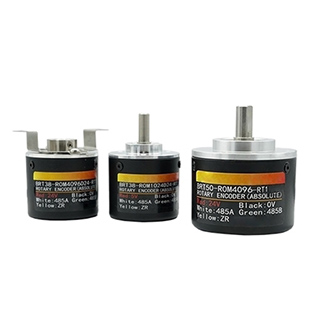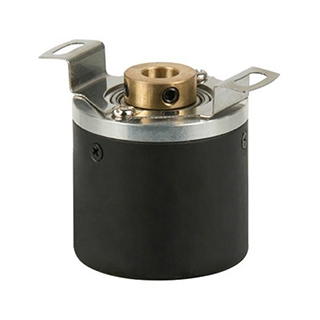Encoder Buying Guide
An encoder is a device that compiles and converts a signal (such as bit-stream) or data into a signal form that can be used for communication, transmission and storage. The encoder converts angular displacement or linear displacement into electrical signals. The former is called a code wheel, and the latter is called a code ruler.
According to the reading method, the encoder can be divided into two types: contact type and non-contact type.
According to the working principle, the encoder can also be divided into two types: incremental type and absolute type.
According to the mechanical installation form of the encoder, it can be divided into shaft type and shaft sleeve type.
Today we will introduce the absolute encoder and incremental encoder in detail, so that you can choose the encoder that is more suitable for you when purchasing.
Absolute encoder
The absolute encoder is a detector that can output the angle data within the motor to an external target. Absolute encoders are generally capable of outputting 360° with 8 to 12 bits. When buying an absolute encoder, you need to understand its working principle, characters and applications.
 Working principle
Working principle
There are many optical channel lines on the optical code disc of the absolute encoder. Each engraved line is arranged with 2 lines, 4 lines, 8 lines and 16 lines. At each position of the encoder, a unique binary code (Gray code) from the zero power of 2 to the n-1 power of 2 is obtained by reading the pass and dark of each scribed line. The absolute encoder is coded by the mechanical position.
It does not need to memorize, do not need to find a reference point, and does not need to count all the time. When you need to know the position, you can read its position. The absolute encoder has a range, suitable for some special machine tools.
Characters
- No need to remember, no need to find reference points, with power-off memory function
- A variety of communication protocols
- Fast start-up speed, precise motion control of multiple axes
- Anti-interference characteristics, corrosion resistance
- High precision, high stability and high reliability.
Applications
Absolute encoders can be used in textile machinery, irrigation machinery, paper printing, water conservancy gates, robots and mechanical arms, port lifting machinery, steel metallurgy equipment, heavy machinery and equipment, precision measuring equipment, machine tools, food machinery, elevators and other special equipment.
Incremental encoder
Incremental encoders are encoders that can generate signals according to rotary motion. The scale method is incremental calculation for each pulse. It is often used with mechanical conversion devices (such as rack-and-pinion, measuring wheels, or spindles) to measure linear motion. Understanding the features and applications of incremental encoders will help you make better purchase choices.
Features
 When the shaft of the incremental encoder rotates, there is corresponding pulse output, and the judgment of the rotation direction and the increase or decrease of the number of pulses are realized by the judgment circuit and counter at the rear.
When the shaft of the incremental encoder rotates, there is corresponding pulse output, and the judgment of the rotation direction and the increase or decrease of the number of pulses are realized by the judgment circuit and counter at the rear.
Its counting starting point can be set arbitrarily, which can realize infinite accumulation and measurement of multiple turns. It is also possible to use the Z signal of one pulse per retransmission as the reference mechanical zero position. One rotation of the encoder shaft will output fixed pulses, and the number of pulses is determined by the number of lines of the encoder grating. When the resolution needs to be improved, the original pulse number can be multiplied by the A and B signals with a phase difference of 90 degrees, or the high-resolution encoder can be replaced.
Incremental encoders have one disadvantage: it will lose axis position in the event of a power failure. However, for absolute encoders, the axis position is not lost even in the event of a power failure.
Applications
Incremental encoders are mainly used in CNC machine tools and mechanical accessories, robots, automatic assembly machines, automatic production lines, elevators, textile machinery, sewing machinery, packaging machinery (fixed length), printing machinery (synchronization), woodworking machinery, plastic machinery (Fixed number), rubber and plastic machinery, plotters, goniometers, convalescent radars, etc.
The last point that should be pointed out is the difference in the nature of incremental encoders and absolute encoders. If you understand this, then this will help you solve the problems when purchasing.
Incremental encoder: The displacement is converted into a periodic electrical signal, and then the electrical signal is converted into a count pulse, and the number of pulses is used to indicate the magnitude of the displacement.
Absolute encoder: Because each position is absolutely unique, anti-interference, and no power-off memory, it has been more and more widely used in angle, length measurement and positioning control in various industrial systems.
For more purchase details, please click on ATO website.

